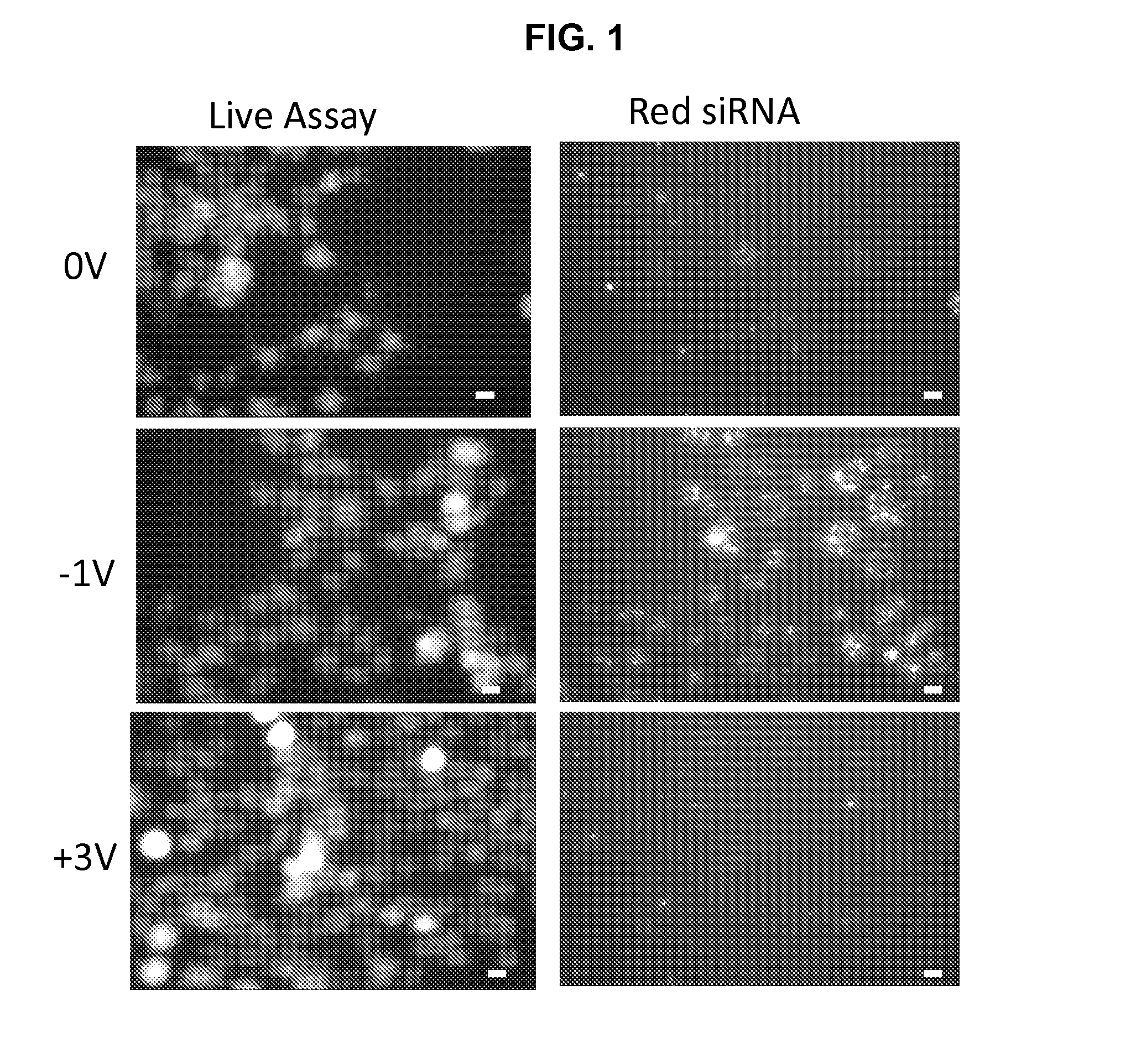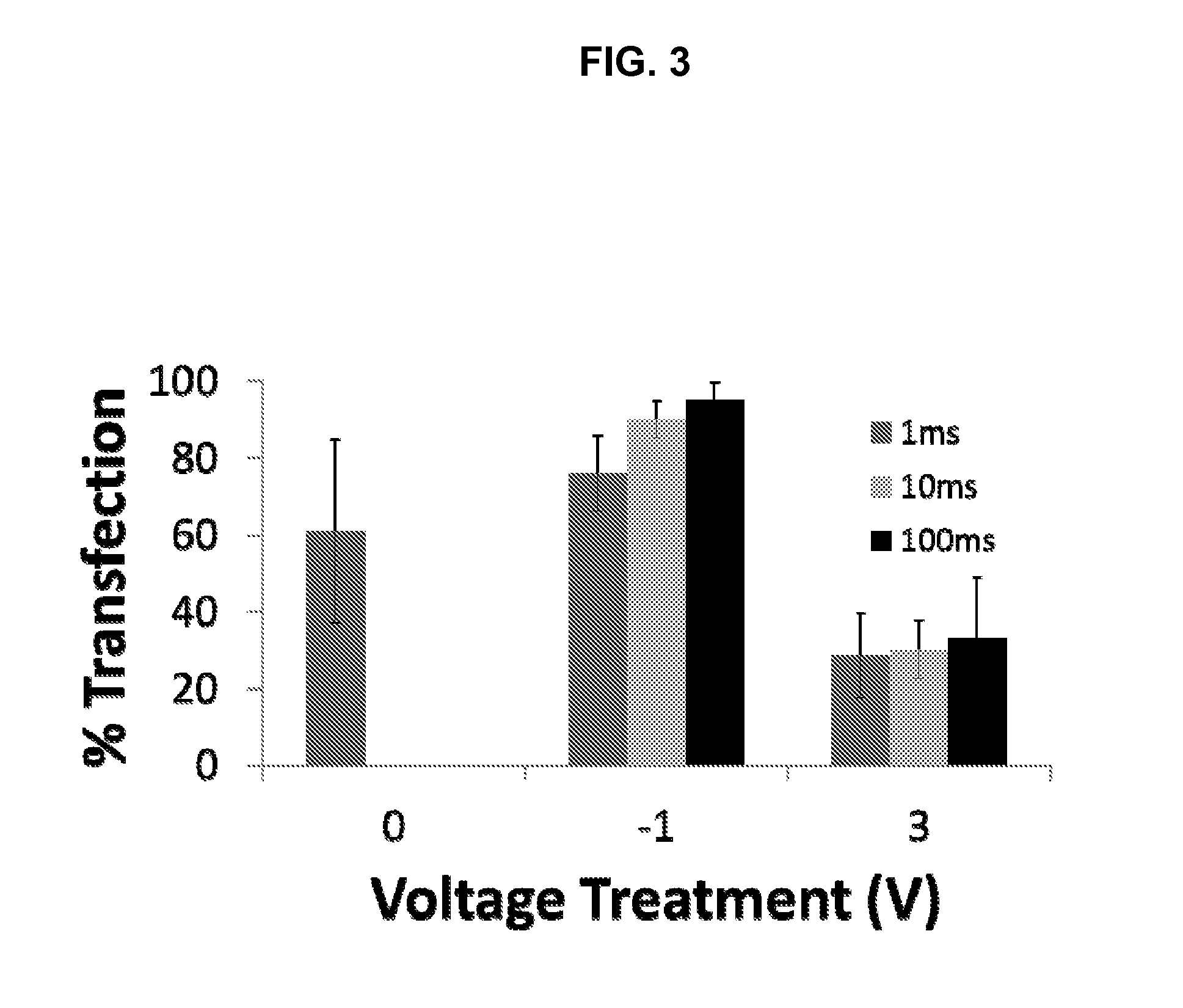METHODS AND COMPOSITIONS FOR HIGH EFFICIENCY TRANSFECTION OF siRNA
a high-efficiency, composition technology, applied in the direction of specific use bioreactors/fermenters, enzymology, after-treatment of biomass, etc., can solve the problems of significant trade-offs between transfection efficiency and viability, difficult-to-transfect cells, etc., to enhance sirna transfection and high efficiency
- Summary
- Abstract
- Description
- Claims
- Application Information
AI Technical Summary
Benefits of technology
Problems solved by technology
Method used
Image
Examples
example 1
Experimental Procedures
[0072]Preparation of Cell Cultures in Indium Tin Oxide (ITO) Wells
[0073]ITO substrates were purchased from Delta Technologies with resistances 10-12 / sq resistance (Delta technologies, Madison, Wis.). Glass wells (1 cm diameter) were attached to the substrates with polydimethyl siloxane (PDMS) (Sylgard 184, Dow Corning) polymer. Prior to cell seeding, the ITO based cell culture wells were thoroughly cleaned, and incubated with 1M sodium hydroxide for 15 min to remove organic residues. Next, the wells were thoroughly washed with distilled water for 6 times, dried and autoclaved for sterility. Neuro2a cells were seeded at 3,000 cells and grown at 37° C. for 24 hrs before transfection in 10% fetal bovine serum, penicillin / streptomycin (Lonza, Walkersville, Md., Catalog#09-757F) 1% antibiotics, advanced MEM media (catalog#12492-Gibco, Life technologies). Primary hippocampal neurons (E18 mice) were purchased from (Brainbits, Llc, Springfield, Ill.) and seeded at 3,0...
example 2
PEI-siRNA Transfection Efficiency is Enhanced with Voltage Pre-Conditioning of Target Cells
[0081]Fluorescently tagged siRNA was complexed with PEI and administered to neuro2a cells that were preconditioned at different voltages. A live cell assay was performed on transfected cells 8 hours after the application of ±1 V, ±3 V, and 0 V (FIG. 1). When no voltage (0 V) was applied to the cells, siRNA transfection efficiencies were 62%±14% in live cells. There was a significant increase in siRNA transfection efficiencies to 98%±3.8% after the application and removal of −1 V. After pre-conditioning the cells at 3 V, 37%±7.5% of the live cells were visibly transfected, however with much less fluorescent intensity in the transfected cells compared to those after pre-conditioning at −1 V. Similar modulation trends were also observed in siRNA loading in primary hippocampal neurons. In primary hippocampal neurons (DIV 4) transfection efficiency with PEI / siRNA complexes was 76%±10% assessed 18 h...
example 3
Determination of the Optimal Pre-Conditioning Voltage and Level of Modulated siRNA Uptake in Cells
[0086]To accurately quantify the level of siRNA loading, neuro2a cells were loaded with fluorescent siRNA using voltage preconditioning, imaged without additional contrast stains, and analyzed for pixel population distribution over different intensities using MATLAB (FIG. 6). siRNA loading in cells was quantified for the voltage range of ±3V (eight different voltage levels). The total sum of red pixels (direct measure of siRNA loading in cells) was highest for marginally negative voltage treatments (−1V and −0.5V) and lowest for voltages greater than ±2V, suggesting a voltage dependent siRNA loading. Analysis of intensity weighted sum of all red pixels above background for 20 randomly chosen cells from each voltage application (total 160 cells) also suggested a voltage dependent loading in cells (FIG. 7). Detailed analysis of the intensity distribution plots for each of the transfected ...
PUM
| Property | Measurement | Unit |
|---|---|---|
| Fraction | aaaaa | aaaaa |
| Electric potential / voltage | aaaaa | aaaaa |
| Electric potential / voltage | aaaaa | aaaaa |
Abstract
Description
Claims
Application Information
 Login to View More
Login to View More - R&D
- Intellectual Property
- Life Sciences
- Materials
- Tech Scout
- Unparalleled Data Quality
- Higher Quality Content
- 60% Fewer Hallucinations
Browse by: Latest US Patents, China's latest patents, Technical Efficacy Thesaurus, Application Domain, Technology Topic, Popular Technical Reports.
© 2025 PatSnap. All rights reserved.Legal|Privacy policy|Modern Slavery Act Transparency Statement|Sitemap|About US| Contact US: help@patsnap.com



